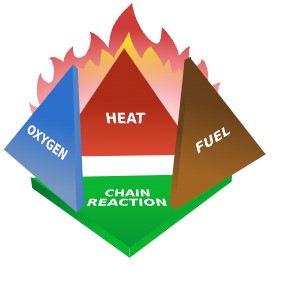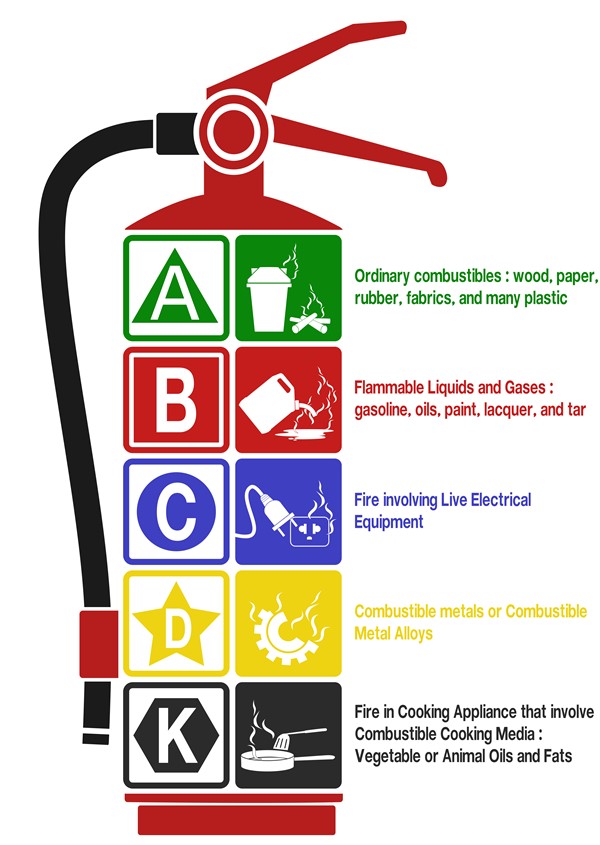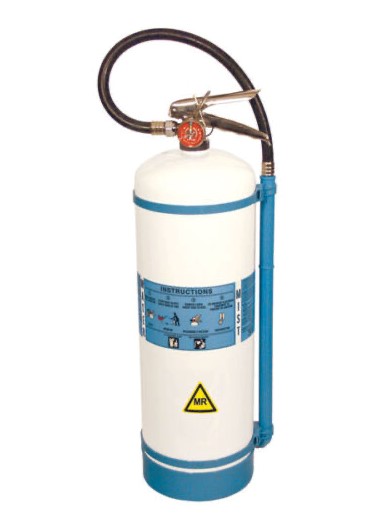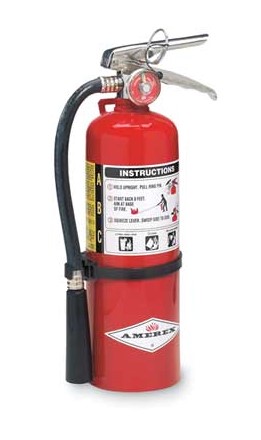Last updated on 5/27/25 | First published on 3/29/23 | Literature review current through Nov. 2025
[cite]
Authors:
Jeff Mize RRT, CHT, UHMSADS,
Tiffany Hamm BSN, RN, CWS, ACHRN, UHMSADS,
Topic editors:
Elaine Horibe Song MD, PhD, MBA,
more...
Coauthor(s)
Jeff Mize, RRT, CHT, UHMSADS
Disclosures: Nothing to disclose
Tiffany Hamm, BSN, RN, CWS, ACHRN, UHMSADS
Chief Nursing Officer, Wound Reference, IncDisclosures: Nothing to disclose
Editors
Elaine Horibe Song, MD, PhD, MBACo-Founder and Editor, Wound Reference, Inc;
Professor (Affiliate), Division of Plastic Surgery, Federal University of Sao Paulo;
Volunteer, Association for the Advancement of Wound Care;
Google Scholar Profile
Disclosures: Nothing to disclose
INTRODUCTION
Background
A fire extinguisher is an item that hyperbaric personnel rarely think about until needed or asked about during an inspection or site visit. Choosing the correct extinguisher type for a specific fire or for purchasing can be made simple by reviewing a few basic concepts. We routinely practice fire occurrence in 3 possible locations: 1) in the chamber, 2) fires in the hyperbaric suite or adjoining room, and 3) fires elsewhere in the hospital or facility. Guidance regarding fires and fire drills is provided by NFPA 99, chapter 14.[1]
When discussing the risk and hazards associated with hyperbaric oxygen therapy physicians, nurses and technologist refer to the Fire Triangle. The Fire Triangle identifies the three components needed for combustion, fuel, heat, and oxygen.

Fig. 1. Fire Triangle
In an article published by Firesafe.org, authors introduce a fourth element or component that must be included. Fire research determined that a fourth element, a chemical chain reaction, was a necessary component of fire. The fire triangle was changed to a fire tetrahedron to reflect this fourth element. A tetrahedron can be described as a pyramid which is a solid having four plane faces. Essentially all four elements must be present for fire to occur, fuel, heat, oxygen, and a chemical chain reaction. Removal of any one of these essential elements will result in the fire being extinguished.[2]
Four elements must be present for fire to occur - heat, oxidizing agent, fuel, and uninhibited chemical chain reaction (aka. Fire Tetrahedron, see Figure 2).
- Oxidizing agent - to sustain combustion.
- Heat - sufficient heat to raise the material to its ignition temperature.
- Fuel - or combustible material.
- Uninhibited Chemical Chain Reaction - an exothermic chemical chain reaction in the material.

Fig. 2. Fire Tetrahedron
Definitions
Fire
- One generally accepted definition of combustion or fire, is a process involving rapid oxidation at elevated temperatures accompanied by the evolution of heated gaseous products of combustion, and the emission of visible and invisible radiation. Oxidation occurs all around us in the form of rust on metal surfaces, and in our bodies by metabolizing the food we eat. However, the key word that sets combustion apart from other forms of oxidation is the word “rapid”.
- The combustion process is usually associated with the oxidation of a fuel in the presence of oxygen with the emission of heat and light. Oxidation, in the strict chemical sense, means the loss of electrons. For an oxidation reaction to occur, a reducing agent the fuel, and an oxidizing agent, usually oxygen must be present. As heat is added, the ignition source, the fuel molecules and oxygen molecules gain energy and become active. This molecular energy is transferred to other fuel and oxygen molecules which creates a chain reaction. A reaction takes place where the fuel loses electrons and the oxygen gains electrons. This exothermic electron transfer emits heat and/or light. If the fire is in a fire grate/ or furnace we refer to this process as a controlled fire, and it is a building on fire we refer to this process as an uncontrolled fire.
Combustion Modes
- The combustion process occurs in two modes:
- Flaming
- Non-flaming (smoldering or glowing embers)
- For the flaming mode it is necessary for solid and liquid fuels to be vaporized. The solid fuel vapors are thermally driven off, or distilled and the liquid fuel vapors evaporated. It is this volatile vapor from the solid or liquid fuels that we see actually burning in the flaming mode. This gas or vapor production, emitted from the fuel is referred to as pyrolysis. Once a flame has been established, heat transfer from the flame to the fuel surface continues to drive off more volatile gases and perpetuates the combustion process. For continued burning in the flaming mode requires a high burning rate, and the heat loss associated with transfer of heat from the flame area by conduction, convection, and radiation must be less than the energy output of the fire. If the heat loss is greater than the energy output of the fire the fire will extinguish.
- Both modes, flaming and non-flaming surface modes, can occur singly, or in combination. Flammable liquids and gases only burn in the flaming mode. Wood, straw, and coal are examples where both modes may exist simultaneously.
Explosion
- Generally, an explosion is defined as a very rapid release of high-pressure gas into the environment. The energy from this very rapid release of the high-pressure gas is dissipated in the form of a shock wave.
- Explosions can be classified as physical, a balloon bursting, as physical and/or chemical, a boiler explosion, or a chemical reaction of a gas/particle mixture.
- The process of a chemical reaction explosion is similar to the combustion process whereby a fuel and oxidant have premixed prior to ignition such as petroleum vapor or fine particles of grain dust mixed with air. However, in an explosion the oxidation process proceeds at a greatly accelerated rate. The oxidation process is usually, but not always, confined within an enclosure such as a tank, grain silo, so that a rapid high-pressure rise occurs with an associated flame front. Generally, it is this high-pressure shock wave that causes the damaging effects from an explosion. Resultant shock waves that propagate from the point of ignition at a velocity less than the speed of sound are termed deflagration. Shock wave velocities in excess of the speed of sound are termed detonations. A rise in pressure creating a shock wave of 6894.76 Pascal’s is sufficient to knock a person down. If the rise in pressure creates a shock wave of 13789.52 Pascal’s to 20684.28 Pascal’s this sufficient to shatter an 8 to 12-inch thick concrete wall. A Pascal (pa) is equivalent to one N/m2.
FIRE EVACUATION
Fire drills should be routinely conducted in the HBOT setting. Depending on the scenario your response may differ, but ultimately our objective is to ensure patient safety. Institutional policies incorporate the fire extinguisher acronyms RACE and PASS in the event staff needs to fight a fire as they evacuate the facility (Figure 1 and 2). It is important to keep in mind we clinicians, are not experts in firefighting. Our primary responsibility in dealing with a fire is to rescue patients.

Fig. 3. R.A.C.E for Fire Safety | 
Fig. 4. P.A.S.S. for Fire Extinguishers |
Videos 1 and 2 below demonstrate burning rate in an increased oxygen environment.
Video 1. Oxygen Enriched Burning Video: Institute of Aviation Medicine, Royal Air Force, Farnborough
VIDEO 2. Oxygen Accelerated Fire Demonstrations
FIRE EXTINGUISHER CLASSIFICATION AND REGULATORY REQUIREMENTS
Fire extinguisher classification

Fig. 5. Fire Extinguisher Classes
The fire extinguisher can be helpful tool creating a pathway for evacuation. It is important to remember that as clinicians we are NOT trained Fire Fighters, and our efforts should not be spent firefighting. Our primary focus is the patient and ensuring they are evacuated in a safe and timely manner.
Regulatory requirements for fire extinguishers
NFPA 99 – 16.10 states that portable fire extinguishers are required throughout the health care occupancy. The type and capacity of fire extinguisher is chosen for a particular location based on the hazard presented by the contents in the area. Pictured below are two types of portable extinguishers found within a hospital (Figures 6 and 7). Each of the extinguishers is labeled with a tag that matches an identifier on the wall or cabinet at that location. [1]
 Fig.6 Portable fire extinguisher |  Fig.7 Portable fire extinguisher |
NFPA 99 – 16.10.1 was added in the 2018 edition, introducing the requirements for extinguisher selection in health care facilities. Previously, guidance on selection did not exist. To avoid the potential for future confusion between NFPA 10 and NFPA 99, the requirement for Class K extinguishers has been removed from NFPA 10.
- Clean agent extinguishers are now required in operating rooms, telecommunication entrance facilities, and telecommunication equipment rooms.
- The definition for clean agent, as defined in NFPA 99, chapter 3 3.3.22:
- Electrically non-conducting, volatile, or gaseous fire extinguisher that does not leave a residue upon evaporation.[4]
NFPA 99 - 14.2.1.2.2 states: The room housing a Class A, Class B, or Class C chamber shall contain a minimum of one 2-A:10B:C portable fire extinguisher.[5]
The Joint Commission standards reference the 2010 edition of NFPA 10, Standard for Portable Fire Extinguishers and NFPA 99, Healthcare Facilities Code:
- The organization is expected to determine and select an appropriate fire extinguisher based upon a site-specific risk assessment that would include but not limited to:
- Potential fire size
- Types of fuels present
- Sources of ignition
- Flammable skin prep products
- Potential for chemical reactions with the extinguishing agent
- Presence of electrical equipment
- The rating of a fire extinguisher is determined by the type of fuel that is being burned. The operating room typically has Class A fuels which would include drapes, paper, and human tissue. Class B fuel would include flammable skin prep products. Class C fires involve energized electrical equipment.
*Note: The NFPA 99 requirement is a minimum guideline. The final determination should be based on the state and local Authority Having Jurisdiction (AHJ), your institutional accrediting body (e.g. Joint Commission, DNV, HFAP).
CATEGORY A CONTINUING EDUCATION CREDIT
This topic has been reviewed and approved by the National Board of Diving and Hyperbaric Medical Technology (NBDHMT) for one (1) Category A Credit.
To claim the credit:
- 1. Read the topic
- 2. Answer the examination and course critique questions.
- 3. After passing, click the provided link to access your certificate. If prompted, sign into your WoundReference account.
For more information on Category A continuing education credits see blog post " Hyperbaric Certification and Continuing Education for Technicians & Nurses".
Official reprint from WoundReference® woundreference.com ©2025 Wound Reference, Inc. All Rights Reserved
NOTE: This is a controlled document. This document is not a substitute for proper training, experience, and exercising of professional judgment. While every effort has been made to ensure the accuracy of the contents, neither the authors nor the Wound Reference, Inc. give any guarantee as to the accuracy of the information contained in them nor accept any liability, with respect to loss, damage, injury or expense arising from any such errors or omissions in the contents of the work.